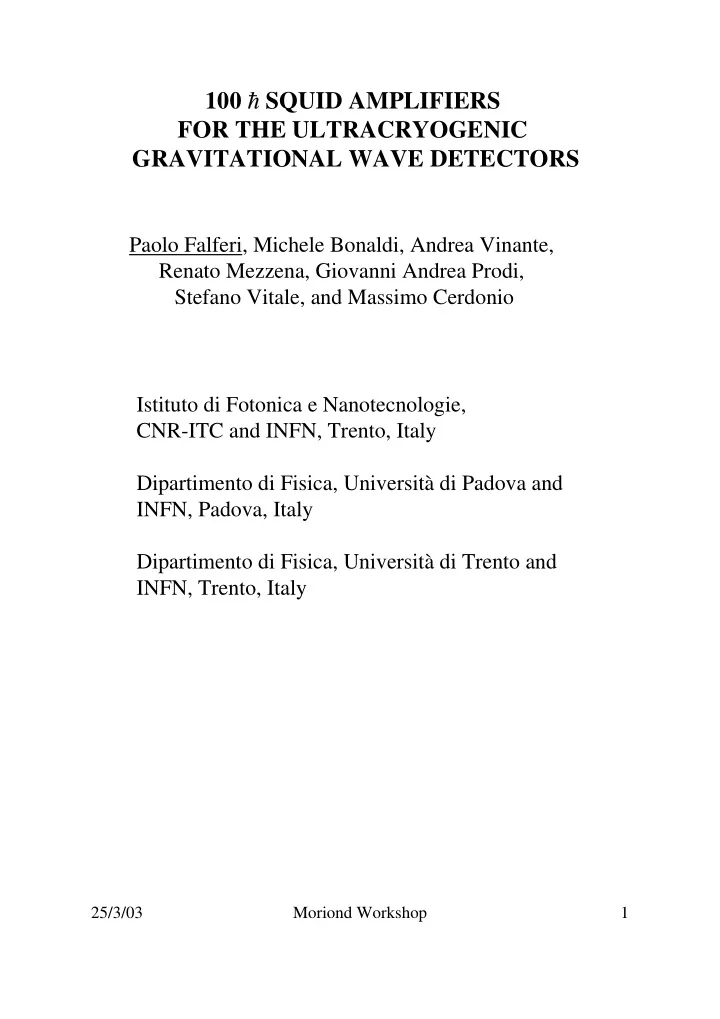

100 h SQUID AMPLIFIERS FOR THE ULTRACRYOGENIC GRAVITATIONAL WAVE DETECTORS Paolo Falferi, Michele Bonaldi, Andrea Vinante, Renato Mezzena, Giovanni Andrea Prodi, Stefano Vitale, and Massimo Cerdonio Istituto di Fotonica e Nanotecnologie, CNR-ITC and INFN, Trento, Italy Dipartimento di Fisica, Università di Padova and INFN, Padova, Italy Dipartimento di Fisica, Università di Trento and INFN, Trento, Italy 25/3/03 Moriond Workshop 1
Resonant Detector Sensitivity Important Factors •Temperature and Q of bar and transducer •Amplifier noise •Matching network 25/3/03 Moriond Workshop 2
Effect of the Amplifier Sensitivity T n =15 µ K ——> ε =350 h T n =0.35 µ K ——> ε =8 h 1E-20 -1/2 ) 1/2 (Hz 1E-21 S hh 1E-22 820 840 860 880 900 920 940 960 980 Frequency (Hz) Two tuned modes (bar and transducer) T bar =100 mK Q + , Q - = 3×10 6 ! Low noise SQUIDs are needed 25/3/03 Moriond Workshop 3
Schematic electromechanical circuit of the g. w. detector AURIGA Transducer Charging Line Decoupling Cryogenic Capacitor Switch Bar L L S SQUID Matching Capacitive Amplifier Transformer Resonant Transducer Besides bar and transducer there is a third electrical mode. 25/3/03 Moriond Workshop 4
Equivalent Electrical Scheme of the AURIGA Detector L BAR C BAR C TR C L TR L L S L i From the point of view of the SQUID the detector is constituted by 3 coupled electrical resonators 1) Bar 2) Transducer 3) resonator given by the transducer capacitance C and the inductance L of the matching transformer primary coil The tuning of the third mode is convenient if 1) its Q is high ( ∼ 10 6 ) 2) its noise is thermal High Q resonators with thermal noise are ! needed 25/3/03 Moriond Workshop 5
Effect of the Tuning of the Third Mode 2 tuned modes 3 tuned modes, Q el =400000 1E-20 -1/2 ) 1/2 (Hz 1E-21 S hh 1E-22 820 840 860 880 900 920 940 960 980 Frequency (Hz) Common characteristics • SQUID T n = 15 µ K • T bar =100 mK • Q + , Q - = 3×10 6 ! A full SQUID noise characterization is needed 25/3/03 Moriond Workshop 6
Summary The reasons for the development of a low noise SQUID able to operate strongly coupled to a high Q LC resonator are •In a noise matched g.w. detector the minimum detectable energy is determined by the SQUID T n •The tuning of the third electrical mode is convenient only if its Q is very high •The LC resonator is a good simulator of the detector •With the high Q LC resonator we can give a full noise characterization of the SQUID amplifier 25/3/03 Moriond Workshop 7
The SQUID Amplifier I IN M i V OUT SQUID operated in L i flux locked loop V n L i SQUID current amplifier I n noise model Typical Expected noise values 2 k TL ≅ ≈ − B SQ 25 2 S 16 10 A Hz i 2 RM i k T ≅ ω ≈ − ω 2 2 37 2 2 3 B S 11 M 10 V Hz v i R ω i L k T ≅ SQ B S 12 iv R 25/3/03 Moriond Workshop 8
Noise Temperature { } = − ≤ Im 2 T S S S 2 k S S 2 k n i v iv B i v B True Energy Resolution ε = ω k B T n 0 Energy Resolution from additive noise (incomplete expression) L S 1 φ ε = = i ' L S i i 2 2 2 M i 25/3/03 Moriond Workshop 9
Two-stage SQUID amplifier SQUID SQUID Sensor Matching Amplifier Network I in V out Feedback Line Advantages • the noise contribution of the electronics at T AMB can be made negligible • the effect of EM interference is reduced • the noise is, in principle, thermal 25/3/03 Moriond Workshop 10
Energy Resolution from additive noise L S L S ε = = Φ i i i ' 2 2 M i 25/3/03 Moriond Workshop 11
Back Action Noise Measurement V n V th L i M r I n L L p C r c ( ) 2 ω ( ) Q k T S M σ = + 2 2 a B v MT G Q ω out R i Q L 2 L L i eq 0 t eq Resonator thermal SQUID back action noise noise 25/3/03 Moriond Workshop 12
Characteristics of the resonators • Resonance frequency = 200 Hz-20 kHz • Q = (2 - 0.5) × 10 6 • L = 20 mH - 7 H • C = 1 - 600 nF 25/3/03 Moriond Workshop 13
Two-stage SQUID Resonance Frequency = 1670 Hz Quality Factor = 1.1 × 10 6 L = 0.55 H C = 19 nF 25/3/03 Moriond Workshop 14
Two-stage SQUID Noise Temperature 200 SQUID Noise Temperature ( µΚ ) 160 11 kHz 120 80 1670 Hz 40 0 0 1 2 3 4 5 Temperature (K) •Intercept different from zero in the 1/f noise region •Slope in agreement with the theory within a factor two 25/3/03 Moriond Workshop 15
TEST FACILITY at Legnaro Labs Ultracryogenic site for the development of transduction systems Mechanical suspensions 90 cm Resonant capacitive transducer Low loss matching stage and SQUID amplifier 25/3/03 Moriond Workshop 16
-7 1x10 2 /Hz -9 1x10 SQUID Output V -11 10 -13 10 800 900 1000 1100 Frequency (Hz) TRANSDUCER + MATCHING STAGE + SQUID •The system is stable •Few spurious peaks in the spectrum TRANSDUCER ELECTRICAL MODE •Q=1.1 × 10 6 •Q=450000 •thermal noise at 4.2 K •thermal noise at 2 - 4.2 K •El. Field 8 × 10 6 V/m TWO-STAGE SQUID •Additive and back action noise as expected •Sufficient dynamic range 25/3/03 Moriond Workshop 17
Recommend
More recommend